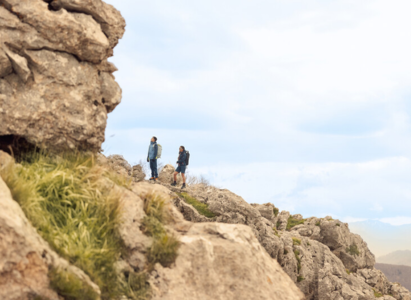
What To Wear When Hiking in Colder Weather?
Layering up for your hike
What is layering and where do you start with it? Well layering is all about having multiple layers of clothing that can added or removed as needed, when the weather changes. But you need to be clever with your layering, some pieces of clothing just aren't made to be worn during a hike.
There are three distinct layers that make up a good cold weather hike outfit. Layer 1 is your base layer, layer 2 is your mid layer, layer 3 is your outer layer.
Your base layer is the first thing that you'll wear for your autumn hike . It sits close to the skin, helps to keep your body heat in and any sweat or moisture out. When you're buying base layers, make sure you don't size up. It's meant to sit close to your skin, it shouldn't feel loose or baggy. The material the base layers are made from are equally as important as the size you get. Avoid buying any base layers that are made using cotton. You want to look for a synthetic material or something like Merino wool. Cotton does the opposite of what you want, it absorbs any sweat and keep it in the clothing, making you feel damp and uncomfortable.
Our base layer sets are made using a mix of synthetic materials including polyester.
The second layer is all about insulation, it needs to be warm, comfortable and breathable all in one. If the weather is particularly cold then you can always wear more than one mid layer. It's always better to have the option to add another layer if you need too. For your top half, you want a fleece ideally, or an insulated jacket. We recommended a fleece as the material works on keeping your body heat in, but it keeps any body moisture out and away from your skin. You can get fleeces in different thickness, so that's something to be aware of, if your planning on double stacking your mid layers.
We have a mix of different fleece and mid layers, full zip, half zip, quarter zip and pull over hoodie styles.
You have two different choices for your outer layer, a soft shell jacket or a hard shell jacket.
Soft shell jackets tend to be more water resistant as opposed to waterproof. They're a lot lighter than hard shell jackets, more flexible and they can also be more breathable. But, if you're going out hiking on a day when it looks like you could potentially get caught in some downpours, then you might want to err on the side of caution and stick to a hard shell waterproof jacket that will definitely keep you dry.
Like the name suggests, hard shell are made using a stiffer material than soft shell. They're designed to keep you dry, and many (including our Dare 2b hiking jackets) are breathable to help allow for sweating and moisture.
So now you're covered on your top half, it's time to think about what you're going to wear on your bottom half.
Hiking or walking trousers are constructed differently than the standard day to day trousers you wear. They tend to be showerproof, which means the fabric won't absorb any water during light showers. Our Dare 2b walking trousers aren't only showerproof, they're also quick drying which helps to keep you dry and comfortable for longer. The stretch fabric provides an improved fit with unrestricted movement.
If you think that you're going to get caught in some larger downpours, you can also bring along overtrousers, which are made with fully waterproof material. They're not suitable to be worn on their own, they're made solely to wear over hiking trousers.
Hiking in Cold Weather
Here at Dare 2b, we're all about getting out and exploring the outdoors, no matter what the weather is like. That's why our Mountain range of outdoor walking and hiking clothing has been created using high tech fabric technologies which include ARED 20/30 which provides industry high levels of both waterproofing and breathability.
The main thing to remember when you are going out hiking in cold weather, is to layer up correctly. This means you're prepared for any changes in the weather and you're not going to be too cold out there.

